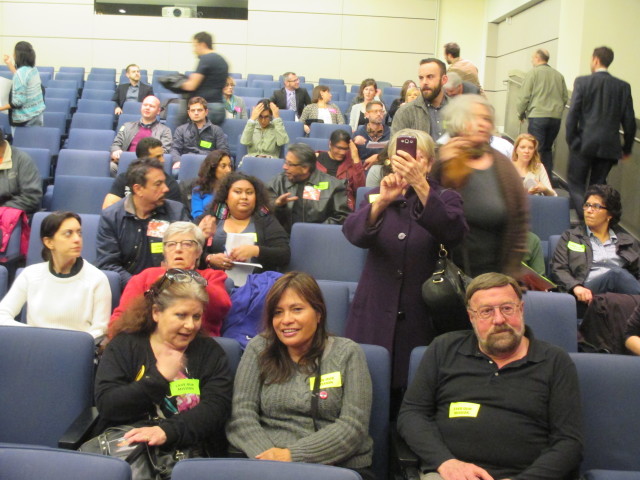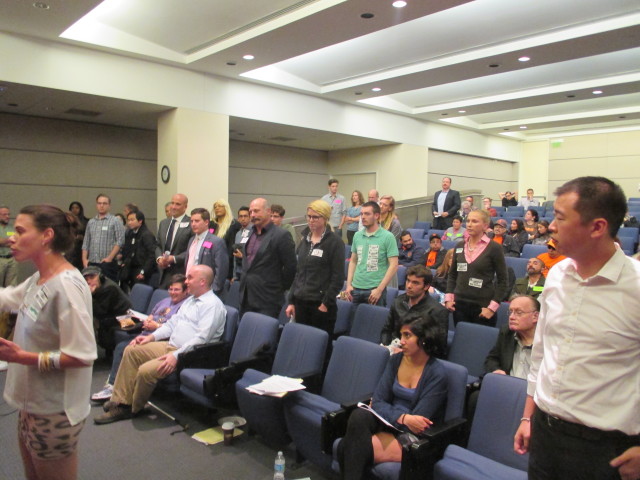County committee rejects community call for a break in runaway development

By Tim Redmond
MAY 28, 2015 – As if there were any doubt left, the Democratic Party of San Francisco demonstrated how far it has gone from its progressive roots and how closely it’s become aligned with the real estate industry last night as the party’s leaders voted against a temporary moratorium on market-rate housing in the Mission.
The vote was 13-10, with Assemblymember David Chiu, who ran for office touting his “shared progressive values,” joining those who voted against the measure.
“The sends a clear message that the Democratic Party is not interested in what the neighborhoods want,” Sup. David Campos, who is sponsoring the moratorium measure, told me after the vote.
The Democratic County Central Committee has no direct authority over land use (or any other city policy), and the measure will still come before the full Board of Supervisors June 2.
But the meeting was an early showcase of exactly what the debate will look like next week – and put every member of the committee on the record on one of the most critical issues in the city.
We saw the arguments on both sides with exceptional clarity. The residents and merchants in the Mission, along with housing advocates from across the city, said that the neighborhood needs a break from the rush of new luxury housing to create a new plan for future development.
Opponents, including Sup. Scott Wiener and the groups SF Bay Area Renters Federation and GrowSF, argue that more development would bring down prices, and anything limiting new projects would just mean higher prices and more evictions.
Most of the people who spoke against the moratorium were white. Some worked in the tech industry. Many of those who spoke in favor were Latino.
In fact, just about every grassroots group in the Mission supports the idea. It’s fair to say that the moratorium plan is something that came out of the community, and has overwhelming community backing.

There were points in the debate when I wanted to tear out what little is left of my hair.
The opponents of the moratorium repeated over and over the mantra that the city needs “all kinds of housing” – as if the private market is going to provide that.
I wanted to stand up and say to the nice folks from SFBARF and GrowSF: You are missing the fundamental reality of the SF housing market.
It’s not rocket science: The private market in SF (and New York) is driven today not by what the residents want, or what the city needs, but by the interests of the international capital markets. Without investment, nobody builds anything – and these days, housing isn’t built in SF by a small-time operator who goes to the local bank for a loan.
No: It’s big real-estate investment outfits that put up the money – and right now, they all want to put their money in luxury housing. That’s just the reality. If you read the Wall Street Journal or the real-estate publications, it’s not a secret.
The reason all that San Francisco is building only high-end housing is because that’s what there’s investment capital for.
Whenever I heard “we need housing at all levels” I want to scream. Yes, we do – and the private market right now can’t and won’t provide that. I feel sorry for the SFBARF folks, who think that if we just allowed more construction, eventually someone would build an apartment they could afford.
It’s not going to happen. We could eliminate all zoning in the Mission, repeal CEQA, get rid of the Planning Commission, abolish public hearings, let the private developers go to town – and there still wouldn’t be any housing built for middle-class people. Not until the Federal Reserve changes the interest rates, and the financial and political situation changes in Russia and China, and the accumulation of wealth and capital among the very rich slows down, and a lot of other factors out of the control of San Francisco elected officials shift, so that the return on investment in high-end housing dips compared to other areas of capital flow.
That may happen someday. It won’t be anytime soon.
Rafael Mandelman, a DCCC member, talked about the testimony we heard from a young woman who grew up in the Tenderloin, whose family owns a hair salon. If that family got evicted, he said, “there is no market solution that would be available to them. Not in the next five years, anyway.”
Exactly.
The Campos moratorium doesn’t stop middle-class housing; it won’t get built anyway. The market is too screwy and dysfunctional.
And by the way, the moratorium wouldn’t apply to affordable housing projects.
Oh, and the evidence is pretty clear that when you build luxury housing in a place like the Mission, it drives up rents in the surrounding areas.
And the moratorium would, in the best case scenario, last no more than two years; in a more likely scenario it would last a year.
All of the luxury housing getting built in other parts of the city would continue – and it will continue not to have any impact on high rents and housing costs.
Fernando Marti, co-director of the Council of Community Housing Organizations, noted that the EIR on the Eastern Neighborhoods Plan a few years ago said that market-rate housing in the Mission would be “naturally affordable.” That was a joke then, and it’s a joke now.
Tom Temprano, former president of the Harvey Milk Democratic Club, pointed out that only 7 percent of the housing in the pipeline for the Mission is slated to be affordable.
“If the Warriors need to shoot 50 percent to beat the Rockets, and they are only shooting 7 percent, what would (coach) Steve Kerr do? He’d call a time out. And that’s what a moratorium is.”
Some of the most powerful testimony came from people who had seen the destruction of the Western Addition, where we increased density, allowed highrise housing – and still have witnessed the outmigration of much of the African American community.
Erik Arguello noted, “remember the Fillmore. We have towers, but there are no African Americans.”
Nathanial Owen, a board member with the Harvey Milk Club, pointed out that there are only 13 sites left in the Mission where the city could buy land for affordable housing.
The hearing got raucous and testy, with both sides cheering and booing and Chair Mary Jung several times having to bang the gavel for order and threaten to adjourn the meeting. At one point, DCCC member Tom Hsieh (more on him later) tried to walk out and force the panel to adjourn.
After two hours of public testimony, Campos introduced the measure by saying that this was really about supply and demand – the supply and the demand for property in the Mission. A couple of years ago, there were 18 sites that were appropriate for the city to acquire for affordable housing. That’s down to 13 – and dropping fast.
If the city doesn’t slow down market-rate development, he said, there won’t be any place left to build the desperately needed affordable units.
Equally important, he said, this was about respecting a neighborhood and a community. There is no deep schism in the Mission; the residents and businesses have organized, created a future plan, and are now begging the city to respect their needs and give them a chance. The status quo has failed.
Former Sup. Bevan Dufty, who now runs the city’s homeless programs, argued that over the past, the city hasn’t done enough for the Mission. “You can legitimately say that this limited moratorium isn’t going to be enough, but there are times in a city when you have to push the reset button,” he said. “Now that we have the resources maybe we can acquire the parcels. I see how the people of the Mission have fought for immigrant rights and sanctuary city. I can’t see this community destroyed by the market forces.”
Wiener argued that the moratorium could extend for two years, and could spread, and stop the market-rate housing that is the main source of financing for affordable housing.
Then Hsieh, in a stunning move, tried to pull a fast one. At almost 11 pm, he (in apparent defiance of process and Roberts Rules) tried to gut the Campos resolution and replace it with a meaningless measure that puts the Democratic Party in favor of “building as much affordable housing as possible.”
That infuriated Mission advocates and Campos, who said it was a transparent attempt to avoid an up or down vote. And that’s exactly what it was. There were activists on both sides who had been there for hours, waiting for a vote.
And eventually, they got one. Hsieh’s amendment failed, and the entire panel had to go on the record.
Voting Yes, with the neighborhood, were Campos, Petra De Jesus, Matt Dorsey, Dufty, Kelly Dwyer, Hene Kelly, Megan Levitan, Mandelman, Eric Mar, and Alix Rosenthal .
Voting No were Kat Anderson, Bill Fazio,Zoe Dunning, Tom Hsieh, Mary Jung, Wiener, Fiona Ma, Trevor McNeil, Leah Pimentel, Rebecca Prozan, Arlo Hale Smith, Francis Tsang, and Chiu.
Joshua Arce ducked and abstained. So did Mark Leno, Phil Ting, Kamala Harris, and Dianne Feinstein. (None of those elected were there, of course, but they had proxies.)
In one of the great moments that showed where the local party has gone, Hsieh made a rambling speech in which he announced that the Democratic Party is a party for all, “the have and the have-nots.”
Think about that. And about who won last night.
Next stop: The Board of Supes. After that, more than likely, the November ballot.






